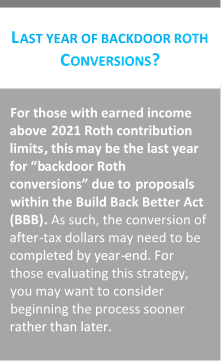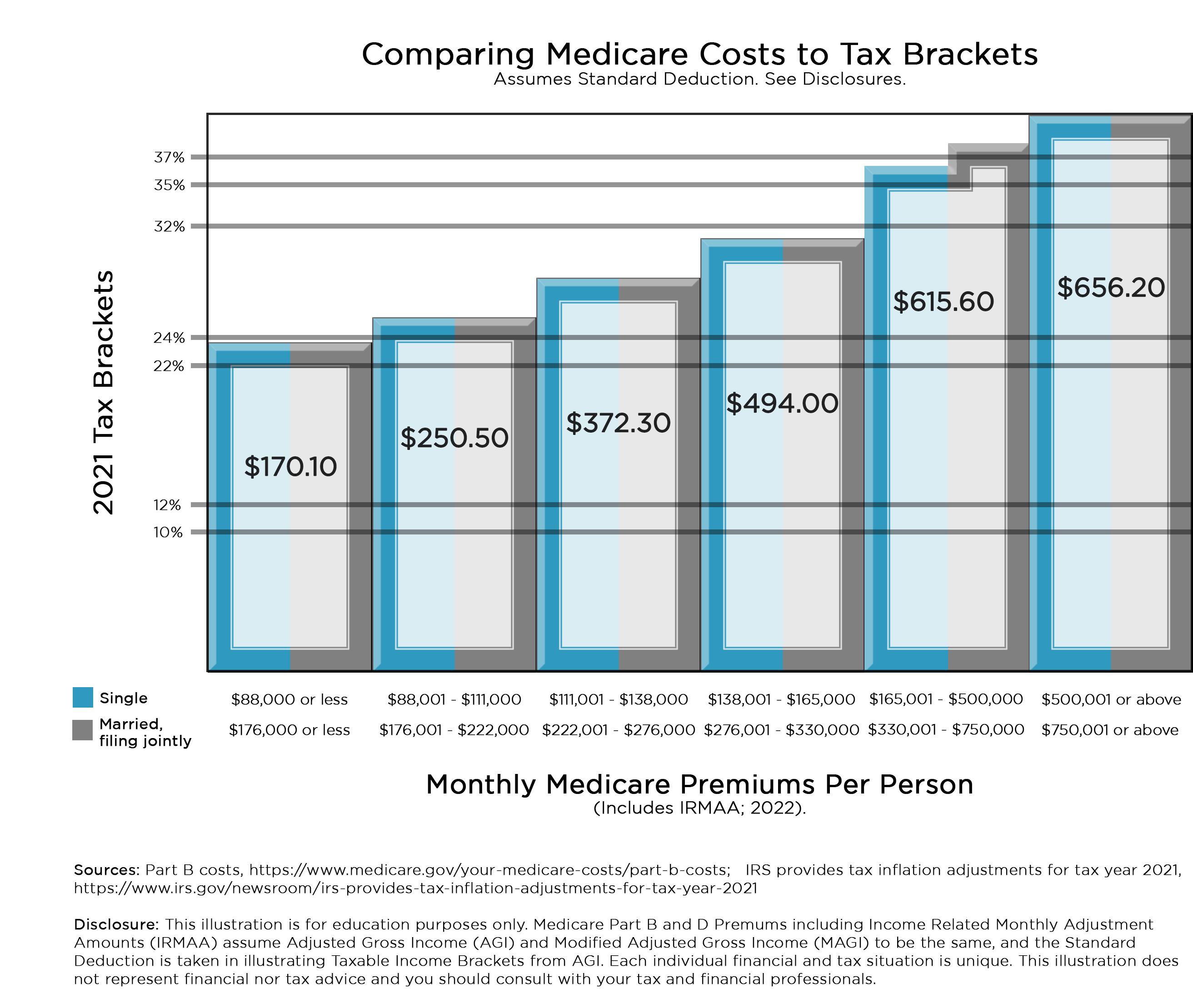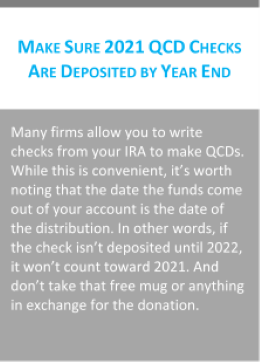November 29, 2021
7 Money-Saving Actions to Take Before Year-End

Guided by evidence and fueled by your ambitions, the Buckingham team is dedicated to creating a wealth strategy distinctly tailored to each individual client’s needs. Before 2021 ends, be sure to check out our list of seven money-saving actions that may help you maintain the greatest amount of after-tax wealth. As always, talk to your advisor to discuss how these could impact your unique situation.
1. Don’t Forget About Required Minimum Distributions (RMDs)
Due to changes in the SECURE Act, the Required Minimum Distribution (RMD) age for traditional IRAs increased to 72. With RMDs eliminated in 2020, this may be the first year which you are actually required to take funds from your traditional IRA or retirement plan. Don’t forget! The penalty for not taking funds out is a 50% tax of the RMD amount, a hefty price to pay for not taking out your own money.
2. Consider Roth Conversions

Work with your financial advisor and tax professional to evaluate if converting funds from your pre-tax retirement accounts to a Roth IRA illustrates tax savings and would be in line with your financial goals. As an example, if you don’t rely on your RMDs to pay the bills or don’t think you will in the future, converting and pre-paying the tax now before balances grow may lead to lower taxes down the road.
3. Explore Tax-Loss Harvesting
For non-retirement accounts, Uncle Sam doesn’t know that your investments are up or down until you sell. The goal of tax-loss harvesting is to generate a tax loss when investment values are down to offset future gains and seek to purchase back a similar (same asset class) but different (not substantially identical per Wash Sale rules) investment.
As this strategy is essentially a tax deferral, it is especially beneficial when losses are generated at higher tax rates and offset by future gains at lower tax rates. If you think that you might have a heavy capital gains burden this year, expect to stay at a similar tax rate, or that your rate may even go down in the future, talk with your financial and tax professionals. They can help you identify whether loss harvesting may be a sound strategy for you.
4. Be Proactive with Your Medicare Costs
Medicare Part B premiums and potential Income Related Monthly Adjustment Amount (IRMAA; the “extra charge” added to your premium) of standard Drug Plan (Part D) premiums are not based on the amount that you pay taxes on (taxable income) but rather on your Adjusted Gross Income (AGI) plus any tax-exempt interest you may have received during the tax year.
For those who turned 63 or older in 2021, keeping an eye on your Modified Adjusted Gross Income (MAGI) could help keep your Medicare costs down. The difference of $1 in 2020 MAGI could cost a married couple up to $2,923 in 2022 numbers.

For retirees, this calculation is generally adding up all your income sources including any retirement distributions (yes, Roth conversions are included), pension income, capital gains, dividends, interest, and the taxable portion of your Social Security (for many, 85% of your gross Social Security benefit). While there may not be a lot you can do to control steady income streams from year to year, harvesting an investment loss or delaying the sale of an investment gain when hovering the fine line of Medicare MAGI tiers may be impactful. You can find the MAGI tiers for Part B and Part D on Medicare’s website, and note they do adjust year to year (generally increasing when inflation is positive) but tier adjustments are not consistent with inflation itself.
Other strategies to potentially reduce MAGI are through Qualified Charitable Distributions (discussed next) for those who are eligible, minimizing retirement account distributions to RMDs and using after-tax, tax-free, or home equity in higher income need years to avoid taking large retirement account distributions, and evaluating if Roth conversions can reduce future RMDs and therefore reduce future MAGI. If you’ve recently retired, went part-time, divorced, or lost a loved one, speak to your financial advisor or tax professional about Social Security Form SA-44 (Medicare Income-Related Monthly Adjustment Amount – Life-Changing Event) to see if you may be eligible to reduce your Medicare premiums.
Speaking of Medicare, check your Part D plan or Medicare Advantage Plan at Medicare.gov by December 7.
5. Over 70½ and Donating to Charity? Consider Qualified Charitable Distributions

You may want to consider making Qualified Charitable Distributions (QCDs) from an IRA (only from an IRA – this can’t be done with retirement plan funds) directly to a qualifying charity. While the donation won’t count toward a charitable deduction, this strategy can be especially efficient for those who don’t itemize deductions (as the distribution isn’t added to income in the first place), essentially bringing back tax efficiency for those who take the standard deduction.
For those 72 and over, QCDs can also be a way to manage Medicare costs when projected MAGI is over $182,000 (2022 “standard premium” limit based on 2020 taxes) and that is because QCDs count toward RMDs and therefore can be used to reduce “counted” retirement distribution amounts. While the $182,000 and other tiers will most likely change (generally increase) for 2023 when 2021 taxes impact Medicare costs, reducing MAGI with QCDs may increase the probability of avoiding an increased cost for someone who is right on the border. This is especially effective for those already donating to charity.
6. Consider “Bunching” Deductions and Donations
With a $12,550 standard deduction for individuals and a $25,100 standard deduction for married couples filing jointly, coupled with an added bonus of $1,350 for each individual over 65, “lumping” or “bunching” deductions may help increase total tax savings over time. Think about it this way – there is no added tax benefit until itemized deductions exceed $25,100 for a married couple, which for many means there is no tax benefit for part, if not all of the charitable donations, property taxes, medical expenses, or state (and municipal) taxes.
A common application of this, for example, is to donate a single $30,000 or $45,000 check to charity – meant to “cover” multiple years – in one year instead of donating $15,000 a year to charity over the next few years. This may lead to a significant itemization in that year, going well above the $25,100 “hurdle” for a married couple, while still obtaining the large standard deduction the following year. To further enhance the efficiency of bunching donations, discuss gifting appreciated stock instead of cash with your financial advisor or tax professional. This strategy may help you avoid paying capital gains tax on the stock, while still taking advantage of full, fair market value deduction of the donated stock.
7. Over 70½ and Still Working? Consider Maximizing Retirement Contributions
If you’re still working after 70½, you also have the added income of Social Security. This may lead to the highest income tax years of your life. Tax-deferred investing may allow you to continue growing your money tax-free until you withdraw the funds, potentially avoiding higher tax brackets now to be taken at lower tax brackets as little further down the road.
Consider maximizing retirement plan benefits through beefing up your 401(k), 403(b), 457, and TSP deferrals up to $19,500 and contributing another $6,500 “catch-up” for a total of $26,000.
Final Considerations
Whether you're able to implement some or most of these ideas, know that effective tax planning is one of the most important ways to increase the chances of meeting your broader life goals. Helping you implement a long-term tax-reduction strategy is an integral role of Buckingham advisors and has far-reaching effects on your overall financial strategy. Talk to your financial advisor today to discuss how these tips, and others, may be impact your unique situation. Don’t have an advisor, let’s chat!
For informational and educational purposes only and should not be construed as specific investment, accounting, legal, or tax advice. This is not intended to be written to be used, and cannot be used, by any individual for the purpose of avoiding penalties which may be imposed by law. Certain information is based upon third-party information which may become outdated or otherwise superseded without notice. Third-party information is deemed to be reliable, but its accuracy and completeness cannot be guaranteed. Individuals should speak with a qualified professional based on his or her circumstances.
By clicking on any of the links above, you acknowledge that they are solely at your convenience and do not necessarily imply any affiliations, sponsorships, endorsements, or representations whatsoever by us regarding third party websites. We are not responsible for the content, availability, opinions, advice, products or services available through them. Neither the Securities and Exchange Commission (SEC) nor any other federal or state agency have approved, determine the accuracy, or adequacy of this article. IRN-21-2998
© Buckingham Wealth Partners (Buckingham Strategic Wealth, LLC. and Buckingham Strategic Partners, LLC., collectively Buckingham Wealth Partners).
Category
Tax StrategiesContent Topics
About the Author

Patrick Kuster
Wealth Advisor
